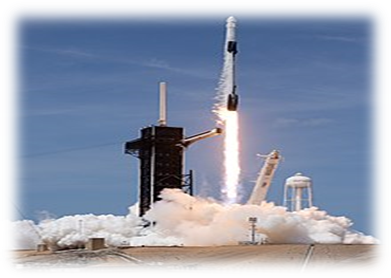Falcon 9
Falcon 9
Introduction:
The two-stages-to-orbit(TSTO) medium lift vehicle designed
by SpaceX is Falcon 9. It is reusable
lift launch vehicle and capable of
re-entering the first stage and landing vertically after separating from second
stage. This feat was achieved for first time on Flight 20.
making SpaceX the first commercial company to visit station. Since Falcon 9 made many
numerous trips to space, delivering
satellites to orbit
as well as delivering satellites to orbit as well as delivering and returning
cargo from space station for NASA.
Is it interesting to know how it work?
As SpaceX develop a reusable launch vehicle ,but how can
this possible……..
In the Falcon 9 , tanks are made of Aluminium lithium alloy,
it makes material stronger and lighter than Aluminium by addition of lithium. There
are two stages are include in Falcon 9 and each tanks capped with Aluminium
dome, which stores liquid oxygen and rocket-grade kerosene (RP-1) engine
propellants. Both stages are equipped with Merlin 1D rocket engines, nine sea-level
adapted versions on the second stage. Every engine uses Pyrophoric mixture of
triethylaluminium – Triethyl borane as engine igniter. Merlin engines are designed for recovery and
reuse.
About Structure :
Height of Falcon 9 with payload fairing = 71 m
Diameter = 3.66m
Weight of the Falcon 9 = 549,000Kg
Thrust produced = 85,000 pounds
Technologies That SpaceX incorporated into Falcon 9 to make Vertical
landing possible
Thrust Vector
control: The Merlin engines of the first boosters are gimballed using hydraulic
actuators that enable the Falcon9 to adjust its Thrust direction.
Cold gas Thrusters : Falcon 9 is equipped
with nitrogen cold gas thrusters that
are mounted on the top of the first stage. Like the gimballed main engines
these cold gas thrusters are responsible for adjusting the orientation of the
rocket.
Re-ignitable First stage engines : The Falcon 9 first stage needs to perform
three separate burns at particular stages of the flight. Hence it is necessary
for the main engines to be re-ignitable.
Onboard Computer :
The Onboard Computer on the Falcon 9 makes flight corrections on the fly to
maintain flight trajectory. The Falcon 9 is equipped with inertial navigation
system(INS) that uses several sensors to measure the position, orientation and
velocity of the rocket.
Deployable grid fins:
As the booster starts to enter the Earth’s
atmosphere ,grid fins come out to stabilize the rocket and slow it down as it
makes its descent.
Landing gear: The Falcon 9 is fitted with a four-legged deployable
landing gear made of strong, lightweight carbon fiber and Aluminium .
Success or Failure Story :
Missions :
Falcon 9 missions
include Cargo delivery and crewed flights
to the ISS with Dragon and Dragon
2 capsules ,launch of communications satellites and Earth observation
satellites to geostationary transfer orbits(GTO) , and low Earth orbits (LEO).
The
heaviest payload launched to LEO are
batches of 53 Starlink satellites
that launch regularly weighting a total
16,250 Kg to 300 Km orbit from 18 March 2022.
=> CRS-25 MISSION
=> SES-22 MISSION
GLOBALSTAR FM15 MISSION
=> SARAH-1 MISSION
=> NILESAT 301 MISSION
=> TRANSPORTER-5 MISSION
Stability calculation in Falcon 9 :
ABOUT SPACEX:
| SpaceX | |
| Type | Private |
|---|---|
| Industry | Space, communications |
| Founded | March 14, 2002 in El Segundo, California, U.S.[1] |
| Founder | Elon Musk |
| Headquarters | |
Key people | |
| Products | |
| Services | Orbital rocket launch, satellite internet |
| Revenue | US$2 billion (2018)[4] |
| Owner | Elon Musk Trust (47.4% equity; 78.3% voting control)[5] |
Number of employees | 12,000[6] (April 2022) |
| Website | www |







Comments
Post a Comment